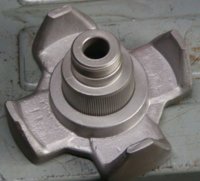I'm curious. 3 major parts of the rotor are,
The main core, with 4 fingers, the keyed taper bore, splines, and the threaded extraction nose.

2nd, the front half rotor core, with 4 fingers, splined hole, threaded holes for the slipring plate.
3rd, the slipring plate, with the timing mark.
When these 3 are reassembled, is the alignment of the keyway with the timing mark assured, or do you have to keep your wits about you?
The main core, with 4 fingers, the keyed taper bore, splines, and the threaded extraction nose.

2nd, the front half rotor core, with 4 fingers, splined hole, threaded holes for the slipring plate.
3rd, the slipring plate, with the timing mark.
When these 3 are reassembled, is the alignment of the keyway with the timing mark assured, or do you have to keep your wits about you?
